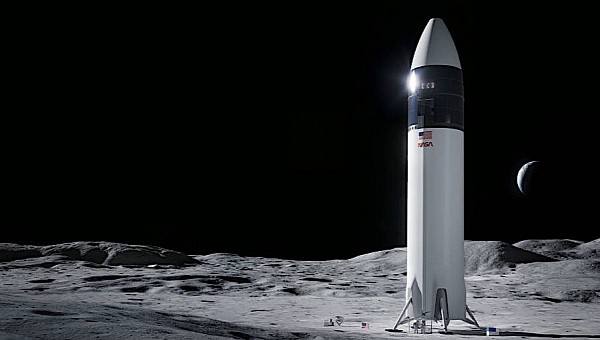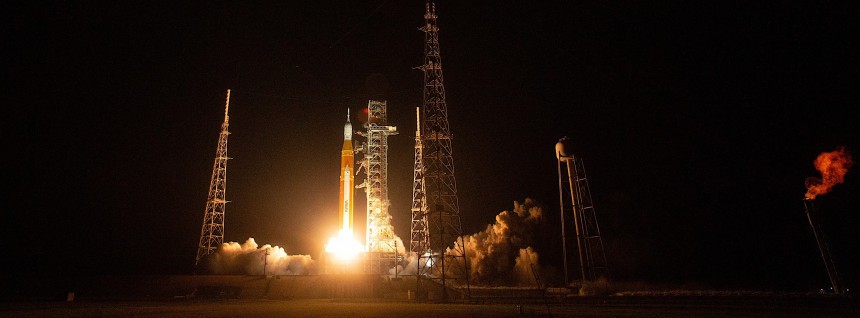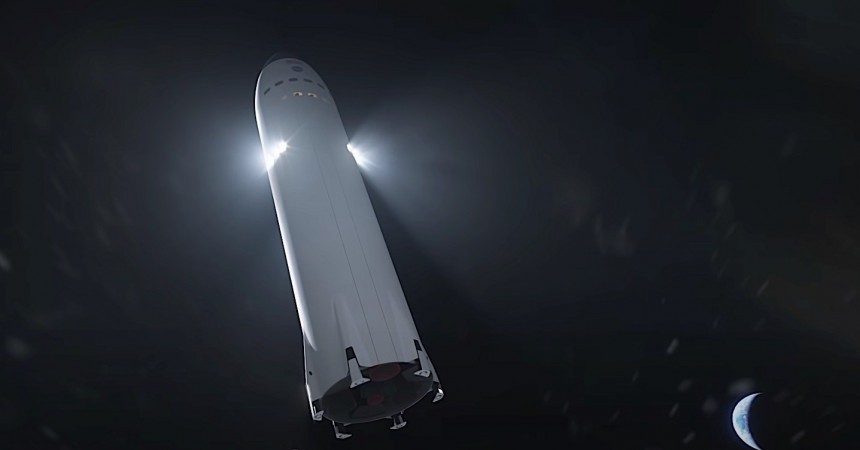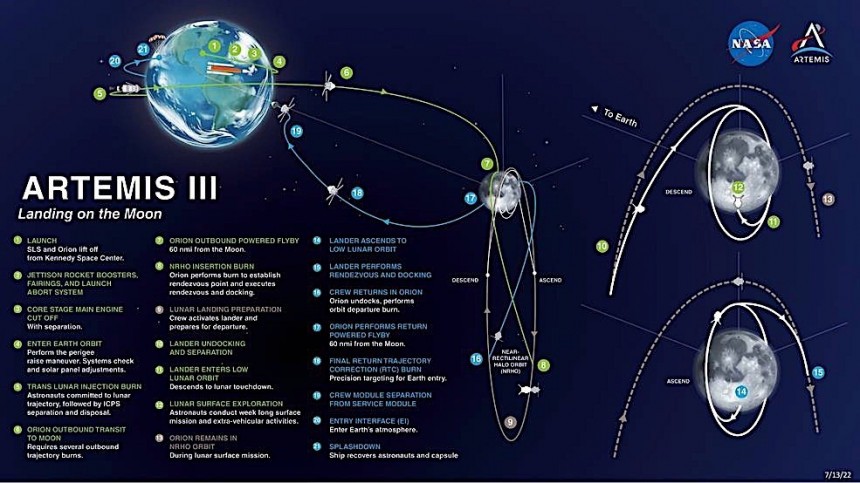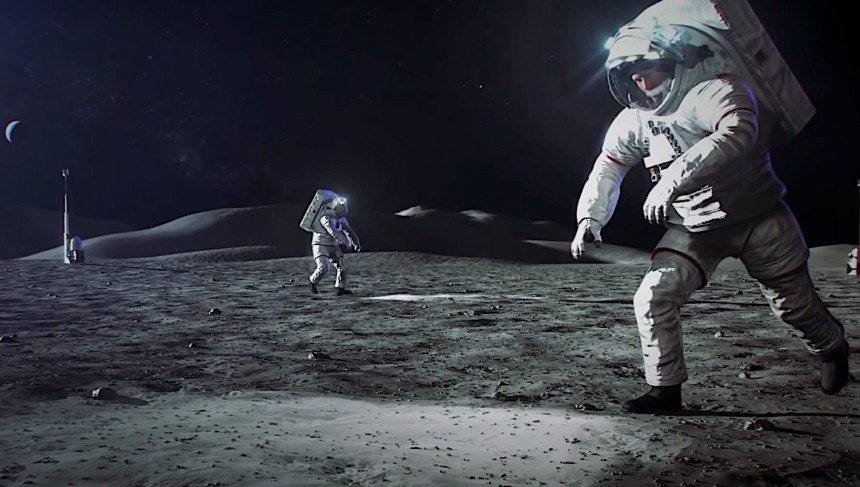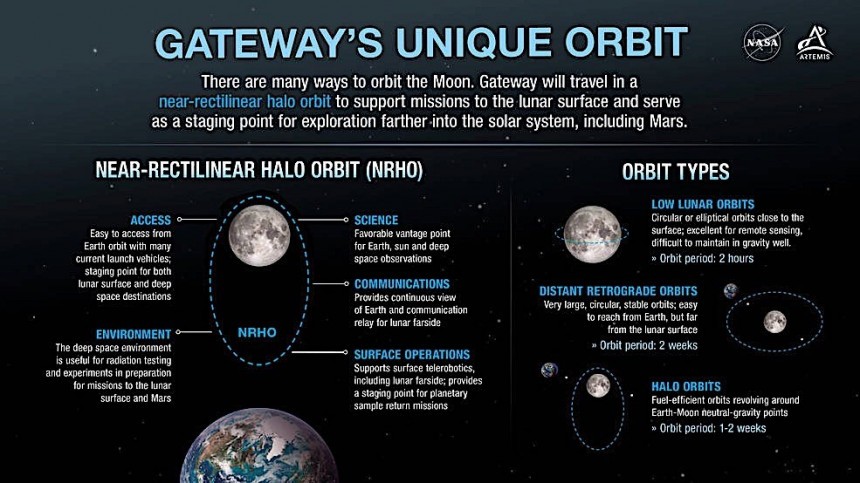Even if at one point it seemed it wouldn’t make it, NASA eventually managed to launch the Space Launch System rocket of the Artemis I mission. It happened in November 2022, was followed by the Orion spaceship spending almost a month in the void of space, and concluded on December 11 with a splashdown in the Pacific Ocean.
By all accounts, Artemis I was spectacular. It marked the moment when, for the first time in the history of mankind, a crew-capable ship traveled a total distance of 1.4 million miles (2.25 million km), going at a record distance of 268,563 miles (432,000 km) from our planet.
UPDATE January 2024: The launch of the Artemis III mission was pushed to September 2026.
It carried with it not only a test mannequin and doll-sized zero-g indicators, but also technologies never sent to space before, like the Callisto, running both the Amazon Alexa virtual audio assistant and Cisco’s Webex communications tool.
Artemis I encountered some problems, both before launch and during flight, but managed to overcome them all and officially kickstart humanity’s second Moon exploration program.
Up next is Artemis II, scheduled for departure sometime next year. Just like the first mission, it will not land humans on the Moon, but will carry some with it on a joyride around our planet’s satellite. We know now the technology works, but we now need to learn if it lives up to astronauts’ standards, and that’s what Artemis II is for.
Artemis III is the effort that will make all space enthusiasts’ dreams come true. At the time of writing, it’s not scheduled to take off before 2025. Yet, probably fueled by the enthusiasm of the Artemis I success, NASA released last week, for the first time, the full details of the mission, as they are known at the moment. They, too, are simply spectacular, and you can read all about them in the lines below.
CREW
The Apollo missions to the Moon in the 1960s were exclusively white-male affairs. Although women and people of color were involved in the overall project, the astronauts who got to touch the stars were all white males. In all, 12 of our finest did that.
That’ll change with Artemis III. The crew of the mission is four people strong, and not all will be of the same sex and race. NASA has made a habit of advertising that the mission will “land the first woman and first person of color on the surface of the Moon.” So far, it didn’t go as far as to say if the first woman and first person of color will be two different people.
The selection hasn’t been made yet, so we don’t know the names of the ones taking a seat in the Orion. We are promised, though, the choice will be made “from among the most diverse astronaut corps in history, each equipped with unique skills and intensively trained.”
HARDWARE
Just like with Artemis I, the crewed mission will make use of the Space Launch System (SLS) rocket and Orion capsule. Granted, improved versions of them.
In the current configuration, and at least until the SpaceX Starship lifts off, the SLS is the most powerful rocket ever made, delivering 8.8 million pounds of thrust during Artemis I. At the moment, it’s also humanity’s only piece of hardware capable of accelerating the Orion to the Moon in a single go.
The Orion, on the other hand, is presently the only spaceship capable of going to the Moon, but, more importantly, safely returning the crew back to Earth, despite the immense speed a lunar return generates. The crew will have to be protected from the dangers of re-entry as the ship they’re in reaches 24,855 mph (40,000 kph) in Earth’s atmosphere.
Unlike Artemis I and II, Artemis III will have to use another piece of hardware, namely a lunar lander. This piece of tech will be built by SpaceX, and it’s the only element of the mission that hasn’t been created and tested yet. So, before the mission gets going, Elon Musk’s company will have to fly the lander at least once to prove it works as needed. It is this element that presently poses the greatest danger to Artemis III not departing in 2025.
LAUNCH
The start of crewed flights to the Moon will not take place before SpaceX launches a series of preparatory missions and the lander itself. The preparatory missions are required because the lander will have to fuel itself in Earth's orbit before heading for the Moon.
In essence, it will go a bit like this. First, SpaceX will send up a storage depot comprising fuel tanks. Then, the human landing system, as it’s now called, will head up as well, to rendezvous and fill its tanks in our planet's orbit. Once that is completed, the ship will head to the Moon, where it will park itself in orbit and await the arrival of humans.
The Artemis III mission will depart Earth in 2025 (hopefully) from the famous Launch Pad 39B at the Kennedy Space Center in Florida. That’s the same place where the Apollo missions left Earth from, but also the origin point for Artemis I.
The SLS will ignite and hurtle itself and the Orion toward the edge of space, in the fashion we’re all so used to by now. Orion will detach, and the crew will spend some time in Earth orbit performing checks and getting the spaceship configured for the journey to the Moon.
A translunar injection maneuver will follow, effectively placing the Orion on a path to the Moon, a journey that will last several days. During all this time, constant corrective burns will have to be performed to keep the spaceship on track.
ARRIVAL
The American space agency decided some time ago to use the so-called Near-Rectilinear Halo Orbit (NRHO) to park the Orion once it reaches the Moon. It’s an orbit perfectly balanced between Earth and the Moon, maximizing the use of fuel, and it brings whatever hardware is placed there both very close to and very far from the surface of the satellite.
More importantly, it can keep communication lines with our planet open at all times. From this orbit, all sites of interest on the surface can easily be reached. NRHO is also the place where NASA and its partners will build the Gateway lunar space station.
Once it gets to NRHO, the Orion spaceship will have to hook up with the SpaceX lander already there. After the required steps are taken, two of the four Artemis astronauts will move inside the lander and undock to head down to the surface.
THE MOON
Artemis III is the first mission to attempt to land humans at the Moon’s South Pole. The place was chosen because there’s a high likelihood of materials needed for future operations to be found, including oxygen and water.
Like before, work will begin almost immediately, with all sorts of science experiments to be conducted both inside the Starship lander and outside, in the unforgiving environment of the Moon. The full extent of research is unknown at the time of writing, but we do know it will include the collection of samples.
For moonwalks, astronauts will all use brand-new EVA suits. They’ll be made by Axiom Space and will be called Exploration Extravehicular Mobility Units (xEMU). For use so far away from home, they’ll have to withstand temperatures between minus 250 degrees Fahrenheit and up to 250 degrees (minus 156 to 121 degrees Celsius).
Even if from the days of the Apollo program we’re used to seeing snapshots of alien worlds from on-site, the level and number of images sent back by Artemis astronauts will be unprecedented. We’re promised lots of photos and videos, probably high-definition and readily available, but also completely new vistas compared to Apollo’s pics from the equator, given how the South Pole is a brand new place we’re exploring.
It's unclear for now how long the Artemis III stay on the surface will be, but it’ll probably not exceed six and a half days. That’s how long it’ll take the Orion spaceship to make a complete orbit and return over the landing site to be able to pick up the landing party.
RETURN
After departing the lunar surface, astronauts will spend another five days in orbit there, transferring samples from the lander to Orion, and getting the ship ready for the return to Earth.
The trip back will be made pretty much in the same fashion as the trip out, with the Orion expected to eventually make a splashdown in the Pacific Ocean, from where the astronauts will be recovered by the U.S. Coast Guard and U.S. Navy.
At the time of writing, three years separate us from the moment of Artemis III launch. Like everything else in space exploration, some details might change, and others might be added as time goes by, so we’ll update this story accordingly.
UPDATE January 2024: The launch of the Artemis III mission was pushed to September 2026.
It carried with it not only a test mannequin and doll-sized zero-g indicators, but also technologies never sent to space before, like the Callisto, running both the Amazon Alexa virtual audio assistant and Cisco’s Webex communications tool.
Artemis I encountered some problems, both before launch and during flight, but managed to overcome them all and officially kickstart humanity’s second Moon exploration program.
Up next is Artemis II, scheduled for departure sometime next year. Just like the first mission, it will not land humans on the Moon, but will carry some with it on a joyride around our planet’s satellite. We know now the technology works, but we now need to learn if it lives up to astronauts’ standards, and that’s what Artemis II is for.
CREW
The Apollo missions to the Moon in the 1960s were exclusively white-male affairs. Although women and people of color were involved in the overall project, the astronauts who got to touch the stars were all white males. In all, 12 of our finest did that.
That’ll change with Artemis III. The crew of the mission is four people strong, and not all will be of the same sex and race. NASA has made a habit of advertising that the mission will “land the first woman and first person of color on the surface of the Moon.” So far, it didn’t go as far as to say if the first woman and first person of color will be two different people.
The selection hasn’t been made yet, so we don’t know the names of the ones taking a seat in the Orion. We are promised, though, the choice will be made “from among the most diverse astronaut corps in history, each equipped with unique skills and intensively trained.”
HARDWARE
In the current configuration, and at least until the SpaceX Starship lifts off, the SLS is the most powerful rocket ever made, delivering 8.8 million pounds of thrust during Artemis I. At the moment, it’s also humanity’s only piece of hardware capable of accelerating the Orion to the Moon in a single go.
The Orion, on the other hand, is presently the only spaceship capable of going to the Moon, but, more importantly, safely returning the crew back to Earth, despite the immense speed a lunar return generates. The crew will have to be protected from the dangers of re-entry as the ship they’re in reaches 24,855 mph (40,000 kph) in Earth’s atmosphere.
Unlike Artemis I and II, Artemis III will have to use another piece of hardware, namely a lunar lander. This piece of tech will be built by SpaceX, and it’s the only element of the mission that hasn’t been created and tested yet. So, before the mission gets going, Elon Musk’s company will have to fly the lander at least once to prove it works as needed. It is this element that presently poses the greatest danger to Artemis III not departing in 2025.
LAUNCH
In essence, it will go a bit like this. First, SpaceX will send up a storage depot comprising fuel tanks. Then, the human landing system, as it’s now called, will head up as well, to rendezvous and fill its tanks in our planet's orbit. Once that is completed, the ship will head to the Moon, where it will park itself in orbit and await the arrival of humans.
The Artemis III mission will depart Earth in 2025 (hopefully) from the famous Launch Pad 39B at the Kennedy Space Center in Florida. That’s the same place where the Apollo missions left Earth from, but also the origin point for Artemis I.
The SLS will ignite and hurtle itself and the Orion toward the edge of space, in the fashion we’re all so used to by now. Orion will detach, and the crew will spend some time in Earth orbit performing checks and getting the spaceship configured for the journey to the Moon.
A translunar injection maneuver will follow, effectively placing the Orion on a path to the Moon, a journey that will last several days. During all this time, constant corrective burns will have to be performed to keep the spaceship on track.
ARRIVAL
More importantly, it can keep communication lines with our planet open at all times. From this orbit, all sites of interest on the surface can easily be reached. NRHO is also the place where NASA and its partners will build the Gateway lunar space station.
Once it gets to NRHO, the Orion spaceship will have to hook up with the SpaceX lander already there. After the required steps are taken, two of the four Artemis astronauts will move inside the lander and undock to head down to the surface.
THE MOON
Artemis III is the first mission to attempt to land humans at the Moon’s South Pole. The place was chosen because there’s a high likelihood of materials needed for future operations to be found, including oxygen and water.
For moonwalks, astronauts will all use brand-new EVA suits. They’ll be made by Axiom Space and will be called Exploration Extravehicular Mobility Units (xEMU). For use so far away from home, they’ll have to withstand temperatures between minus 250 degrees Fahrenheit and up to 250 degrees (minus 156 to 121 degrees Celsius).
Even if from the days of the Apollo program we’re used to seeing snapshots of alien worlds from on-site, the level and number of images sent back by Artemis astronauts will be unprecedented. We’re promised lots of photos and videos, probably high-definition and readily available, but also completely new vistas compared to Apollo’s pics from the equator, given how the South Pole is a brand new place we’re exploring.
It's unclear for now how long the Artemis III stay on the surface will be, but it’ll probably not exceed six and a half days. That’s how long it’ll take the Orion spaceship to make a complete orbit and return over the landing site to be able to pick up the landing party.
RETURN
After departing the lunar surface, astronauts will spend another five days in orbit there, transferring samples from the lander to Orion, and getting the ship ready for the return to Earth.
The trip back will be made pretty much in the same fashion as the trip out, with the Orion expected to eventually make a splashdown in the Pacific Ocean, from where the astronauts will be recovered by the U.S. Coast Guard and U.S. Navy.
At the time of writing, three years separate us from the moment of Artemis III launch. Like everything else in space exploration, some details might change, and others might be added as time goes by, so we’ll update this story accordingly.
